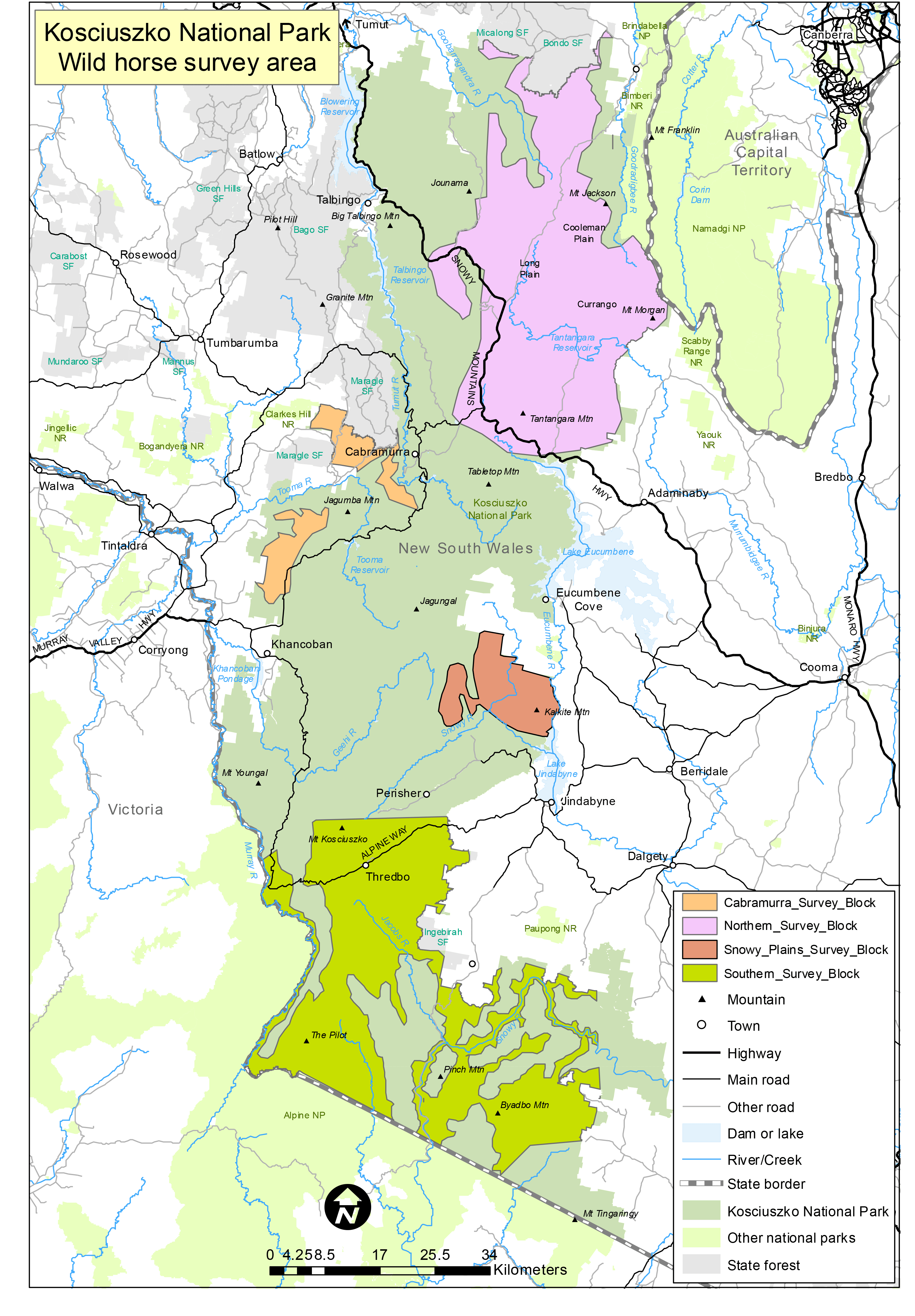Additional 2023 horse population survey data released
The National Parks and Wildlife Service has released supplementary explanatory information and raw data collected as part of the 2023 wild horse population survey in Kosciuszko National Park:
Kosciuszko National Park is 3 times larger than the Australian Capital Territory and the same size as the island of Bali. Determining the wild horse population by counting every animal is impossible in such large, rugged and remote terrain.
Regular scientific surveys are conducted in accordance with international best practices to estimate the population of wild horses in the park.
Surveys are designed and analysed by an expert from the University of New England. The results are peer-reviewed by independent experts from the CSIRO (Commonwealth Scientific and Industrial Research Organisation) and Queensland Department of Agriculture and Fisheries.
Wild horses are estimated to occur across more than 50% of the park, with most of the wild horse population occurring in the park's northern block.
The National Parks and Wildlife Service is legally required to reduce the population of wild horses to 3,000 and limit their range to 32% of the park by June 2027.
The next population survey will occur before the end of 2024.
The wild horse survey uses the international best practice method for reliably estimating the population of large mammals over wide geographic areas, known as distance sampling. More than 1,500 peer-reviewed scientific papers use distance sampling to estimate wild animal populations.
The survey methodology, originally developed to measure wild horse populations across the Australian Alps, was peer-reviewed by the University of St Andrews, Scotland.
The design, analysis and reporting of the 2020, 2022 and 2023 surveys was completed by an independent expert from the University of New England.
The 2020, 2022 and 2023 survey reports were peer-reviewed by independent experts from the CSIRO and the Queensland Department of Agriculture and Fisheries.
The survey is conducted from a helicopter across 4 large areas covering around 39% or 267,500 square kilometres of the park. The areas have been known to support wild horse populations.
The helicopter flies a series of parallel lines, known as transects, in each survey area at a height of 61 metres and a speed of 93 km/hour. The total length of transects flown in the 2020 and 2022 surveys was 1,496 kilometres. The 2023 survey incorporated some improvements to design, including additional transects in the northern and southern survey blocks in order to increase the precision of population estimates. The total length of transects flown in 2023 was 1,939 kilometres.
Two specialist observers stationed on either side of the aircraft record sightings of wild horses and related data, such as the distance an individual animal or cluster of animals is away from the observer, habitat cover at point of detection, and cloud cover.
The sample of observations is then analysed by an independent expert using advanced software to reliably estimate the wild horse population in the entire survey area.
While there is anecdotal evidence suggesting wild horses occur in other areas of the park, for the purposes of the estimate it is assumed the wild horse population is zero outside of the survey area.
Statisticians and scientists use a confidence interval to express how reliable an estimate is. A 95% confidence interval is the accepted convention in biological sciences.
For the 2023 survey we can be 95% confident that the wild horse population is more than 12,797 and less than 21,760 wild horses, with the best estimate being 17,393 horses.
The chance of the population being significantly outside of the lower and upper limit is very small.
It is rare that a count (or census) of an entire animal population can be undertaken in the wild, whether by air or ground.
The park's size and mix of rugged mountain escarpments, valleys and wilderness areas means it is impossible to count every wild horse in the landscape individually.
Instead, the National Parks and Wildlife Service uses the internationally recognised best practice method to estimate the wild horse population.
The design of the survey ensures that wild horses are not double-counted. The helicopter routes (transects) are flown sequentially in a single direction, 1.5 km apart in the northern and southern blocks, 900 metres apart in the Cabramurra block, and 700 metres for the Snowy Plains block. This reduces the likelihood of re-observing wild horses that might move in response to the helicopter.
The next population survey is scheduled to be conducted before the end of 2024.
Surveys will occur each year while the plan is being implemented to ensure populations are tracked regularly into the future.

Survey of the wild horse populations in the Kosciuszko National Park – 4 survey blocks within the Kosciuszko National Park
More information
- A survey of the wild horse population in Kosciuszko National Park October 2023
- 2022 survey of the wild horse population in Kosciuszko National Park
- Kosciuszko National Park wild horse populations survey 2020
- Distance sampling explainedopens a new window
- Distance sampling referencesopens a new window
- Australian Alps National Parks feral horse surveysopens a new window